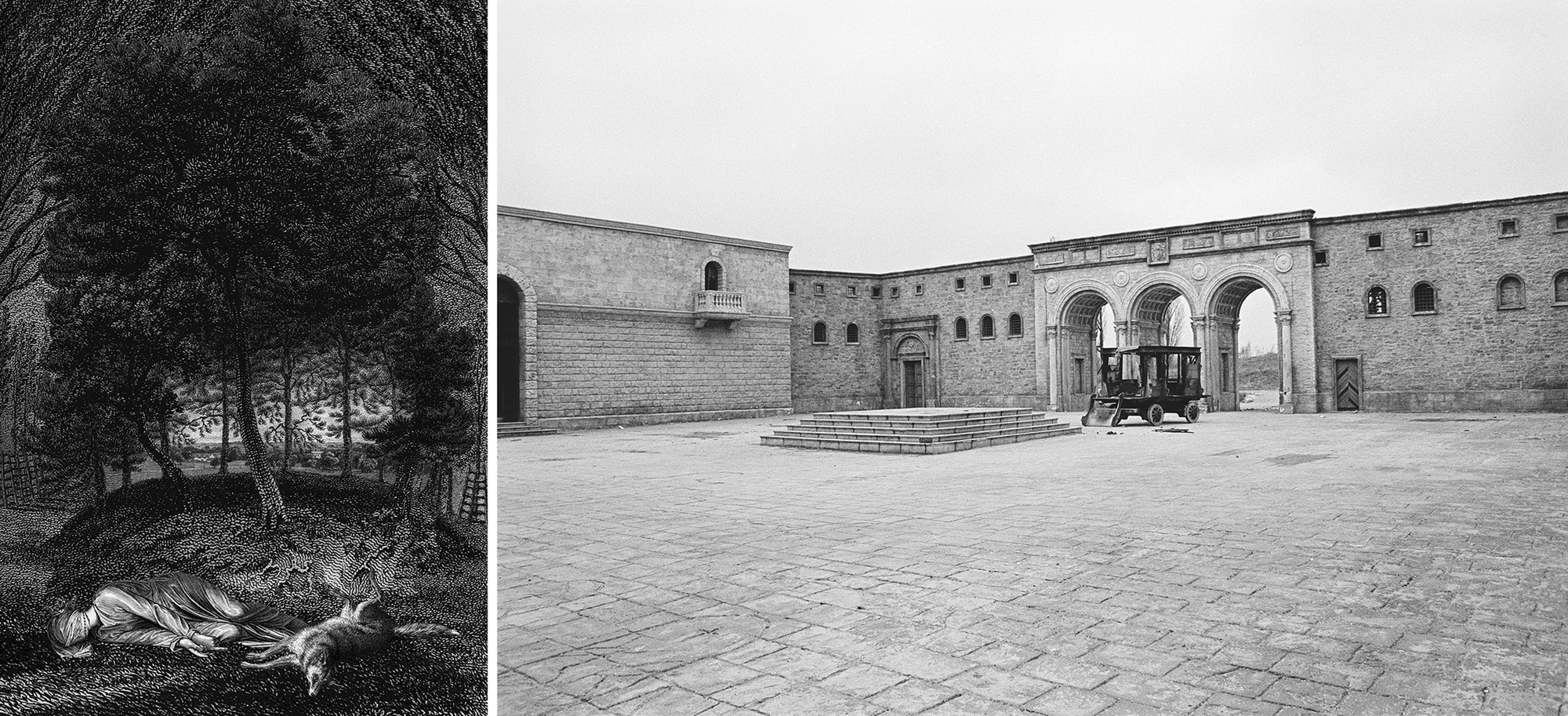The Fortress Of Solitude From The Holy Wood Of Eteranl Noise
Chapter IV of The White Dot and The Black Cube, an exhibition project in six parts
07 Jul - 28 Aug 2016

Left: Larisa Sitar And then, one thing led to another...,
digital collage, variable dimensions, 2014-2016
Ridht: Roman Štětina Plot of Land
b&w photography, 2015
digital collage, variable dimensions, 2014-2016
Ridht: Roman Štětina Plot of Land
b&w photography, 2015
THE FORTRESS OF SOLITUDE FROM THE HOLY WOOD OF ETERANL NOISE
Chapter IV of The White Dot and The Black Cube, an exhibition project in six parts
07 July - 28 August 2016
Curators: Diana Marincu and Anca Verona Mihuleţ
Larisa Sitar (RO) and Roman Štětina (CZ)
This exhibition analyses the self-imposed distances in the outer world and the zones of intimacy in the inside world, taking its starting point from what the Fortress of Solitude could signify. The four dimensions of the hierarchization of human contact – intimate distance, personal distance, social distance and public distance – determine a polarization of interaction composed by two clearly defined areas – private space and public space.
Larisa Sitar’s heroes are usually anonymous characters, wrought with the atmosphere of fairy-tales, borrowed from the repertoire of collective consciousness, with a strong awareness of their transience. They utilize sleep as a bridge into the dimension of meditation, into a time of suspension in which they regenerate and accept themselves. Roman Štětina’s heroes are figures adopted from the radio and TV broadcasting industry of the 1960s and 1970s, some of them brought to light from behind the curtain, others pulled directly from the screen, visible and invisible at the same time.
The history to which Larisa Sitar usually refers is not something stable or finished, but rather an occasion for a suspension of the ideologies on which it is built, for opening up toward such micro-narratives as those from a village in Maramureș. The series of audio works “Don’t let me die, ‘cause I won’t let you live!” is made up of recordings of people recounting, at the boundary between day and night, their experiences of confronting supernatural forces or the embodiments of their worst fears. Larisa Sitar often uses diffident characters, voices without faces, disguised identities and phantomatic spaces that coincide with them, at the same time showcasing their force of telling stories and constructing themselves.
Štětina’s film, “Lost Case”, was created by means of re-editing emblematic scenes from the movie series Colombo, following the main character from the beginning of the series, when the protagonist, Peter Falk, is still young, to the last episode, shot at the beginning of the 1990s, when Peter Falk is grey-haired and has difficulties moving around. Almost 200 hours of film were edited in order to identify the scenes in which Colombo arrives at the crime scene and finds the clue that constitutes the key to solving the mystery. The sound is completely removed and replaced by a symphonic leitmotiv marking certain scenes.
Chapter IV of The White Dot and The Black Cube, an exhibition project in six parts
07 July - 28 August 2016
Curators: Diana Marincu and Anca Verona Mihuleţ
Larisa Sitar (RO) and Roman Štětina (CZ)
This exhibition analyses the self-imposed distances in the outer world and the zones of intimacy in the inside world, taking its starting point from what the Fortress of Solitude could signify. The four dimensions of the hierarchization of human contact – intimate distance, personal distance, social distance and public distance – determine a polarization of interaction composed by two clearly defined areas – private space and public space.
Larisa Sitar’s heroes are usually anonymous characters, wrought with the atmosphere of fairy-tales, borrowed from the repertoire of collective consciousness, with a strong awareness of their transience. They utilize sleep as a bridge into the dimension of meditation, into a time of suspension in which they regenerate and accept themselves. Roman Štětina’s heroes are figures adopted from the radio and TV broadcasting industry of the 1960s and 1970s, some of them brought to light from behind the curtain, others pulled directly from the screen, visible and invisible at the same time.
The history to which Larisa Sitar usually refers is not something stable or finished, but rather an occasion for a suspension of the ideologies on which it is built, for opening up toward such micro-narratives as those from a village in Maramureș. The series of audio works “Don’t let me die, ‘cause I won’t let you live!” is made up of recordings of people recounting, at the boundary between day and night, their experiences of confronting supernatural forces or the embodiments of their worst fears. Larisa Sitar often uses diffident characters, voices without faces, disguised identities and phantomatic spaces that coincide with them, at the same time showcasing their force of telling stories and constructing themselves.
Štětina’s film, “Lost Case”, was created by means of re-editing emblematic scenes from the movie series Colombo, following the main character from the beginning of the series, when the protagonist, Peter Falk, is still young, to the last episode, shot at the beginning of the 1990s, when Peter Falk is grey-haired and has difficulties moving around. Almost 200 hours of film were edited in order to identify the scenes in which Colombo arrives at the crime scene and finds the clue that constitutes the key to solving the mystery. The sound is completely removed and replaced by a symphonic leitmotiv marking certain scenes.
